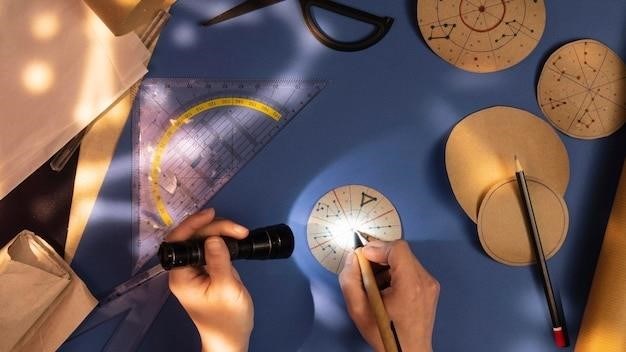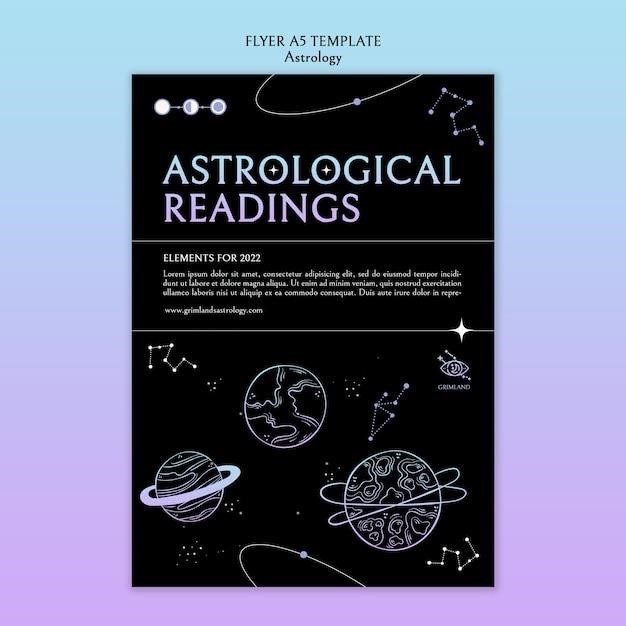Lecture Tutorials for Introductory Astronomy⁚ Course Structure
Lecture Tutorials for Introductory Astronomy utilizes a variety of resources, including Pearson’s eTextbooks, supplementary lecture slides, and online platforms providing access to videos and study materials․ The OpenStax Astronomy textbook is a core resource, supplemented by interactive activities․
Textbook Resources and Access
This introductory astronomy course leverages multiple textbook resources to ensure comprehensive learning․ The primary text is often the OpenStax Astronomy textbook, freely available online and known for its clarity and comprehensiveness․ Students gain access to this resource through online platforms integrated into the course structure․ Pearson’s “Lecture Tutorials for Introductory Astronomy” (various ISBNs, including 9780137619641 and 9780135807026) provides a crucial supplement, offering collaborative learning activities and inquiry-based exercises designed to enhance conceptual understanding․ These tutorials are often available in both print and digital formats․ The course may also utilize additional supplementary materials, such as lecture slides and online resources, enriching the learning experience and providing multiple avenues for engaging with the course content․ Access to these resources is typically managed through the course’s online learning management system (LMS)․
Collaborative Learning Activities
A cornerstone of this introductory astronomy course is its emphasis on collaborative learning․ The “Lecture Tutorials for Introductory Astronomy” textbook actively promotes this approach through a series of specifically designed activities․ These activities are structured to encourage peer interaction and discussion, fostering a deeper understanding of complex astronomical concepts․ Students work together to solve problems, analyze data, and interpret observations, promoting active learning and knowledge construction․ The collaborative nature of these activities encourages students to articulate their reasoning, explain their thought processes, and learn from their peers’ perspectives․ This interactive learning environment enhances critical thinking skills and cultivates a more robust comprehension of the subject matter compared to passive learning methods․ The tutorials provide a framework for these collaborative activities, guiding students through inquiry-based explorations of key astronomical phenomena․
Inquiry-Based Learning Methods
The “Lecture Tutorials for Introductory Astronomy” series strongly incorporates inquiry-based learning․ Instead of passively receiving information, students actively participate in investigating astronomical concepts․ The tutorials present scenarios and questions that challenge students to analyze data, formulate hypotheses, and draw conclusions․ This approach mirrors the scientific method, encouraging students to think critically and develop their problem-solving skills․ By engaging with real-world astronomical data and challenges, students develop a deeper understanding than through rote memorization․ The emphasis is on the process of scientific inquiry, not just the final answers․ This method fosters a more robust understanding of astronomy’s underlying principles and cultivates a scientific mindset․ This hands-on approach strengthens critical thinking and scientific reasoning abilities crucial for future learning and application․

Content Delivery and Formats
The course utilizes a blended learning approach․ Video lectures, often broken into shorter segments for flexibility, are complemented by interactive lecture tutorials and supplementary materials․
Video Lecture Series and Accessibility
A comprehensive video lecture series accompanies the course materials․ These videos, based on the OpenStax Astronomy textbook and designed for a 14-week course, are broken down into approximately 15-minute segments․ This allows instructors flexibility in selecting the most appropriate content for their students’ needs and the course’s pace․ The videos aim for accessibility, potentially including captions or transcripts for students with hearing impairments․ Instructors can choose to incorporate the entire series or select specific videos to complement their teaching style and curriculum․ The availability of these videos online enhances the learning experience, providing students with multiple avenues for accessing and reviewing the course material at their convenience․ Furthermore, the modular design of the video lectures allows for easy integration into various learning management systems, promoting a seamless educational experience․
Supplementary Lecture Slides and Materials
In addition to the video lecture series, a robust collection of supplementary lecture slides and materials are provided to enrich the learning experience․ These resources are designed to complement the video lectures and textbook, offering alternative perspectives and additional details on key concepts․ The slides often include visual aids, diagrams, and summaries to help students grasp complex astronomical phenomena․ Furthermore, these supplementary materials may incorporate interactive elements, such as quizzes or exercises, to reinforce learning and encourage active engagement․ They are readily available online, ensuring convenient access for students․ The supplementary materials are intended to cater to diverse learning styles, providing a flexible and comprehensive support system for students throughout the course․ Instructors can utilize these resources to tailor their teaching approach and cater to the specific needs of their students․
Course Content Overview
This introductory astronomy course comprehensively covers celestial objects, cosmology, and observation techniques․ The curriculum explores the universe’s structure and the methods used to study it․
Celestial Objects and Phenomena
This module delves into the fascinating world of celestial objects and the phenomena that shape them․ We’ll explore the characteristics of stars, from their life cycles and stellar evolution to the different types of stars found throughout the universe, including white dwarfs, neutron stars, and black holes․ We will also investigate planets, both within our solar system and exoplanets orbiting other stars, examining their formation, composition, and potential for habitability․ The study of nebulae, those stunning clouds of gas and dust where stars are born, will be a key component, along with an exploration of galaxies, their diverse forms, and their role in the large-scale structure of the cosmos․ Finally, we’ll discuss transient phenomena, such as supernovae and gamma-ray bursts, and the valuable insights they offer into the universe’s dynamic processes․ The module will be richly illustrated with images and visualizations, enhancing understanding․
Cosmology and the Universe’s Structure
This section explores the vast scale of the universe, delving into the fundamental principles of cosmology; We’ll examine the Big Bang theory, the prevailing model for the universe’s origin and evolution, tracing its expansion from the initial singularity to its current state․ Discussions will include the cosmic microwave background radiation, a crucial piece of evidence supporting the Big Bang․ We’ll investigate the composition of the universe, focusing on dark matter and dark energy, mysterious components that significantly influence its expansion and structure․ The large-scale structure of the cosmos, including the distribution of galaxies in clusters and superclusters, will be examined․ We will also explore different cosmological models and the ongoing research aimed at refining our understanding of the universe’s past, present, and future․ Key concepts like redshift, Hubble’s Law, and the accelerating expansion of the universe will be explored with clear explanations and examples․
Astronomical Observation Techniques
This module details the methods astronomers use to gather data about celestial objects․ We’ll begin with an overview of ground-based telescopes, exploring different designs like refractors and reflectors, and discussing the importance of adaptive optics in overcoming atmospheric distortions․ The advantages and disadvantages of various telescope locations, such as high-altitude observatories, will be analyzed․ The course will then transition to space-based astronomy, examining the capabilities of orbiting telescopes like Hubble and its successors, highlighting their ability to observe across the electromagnetic spectrum unhindered by Earth’s atmosphere․ Specific observational techniques will be covered, including spectroscopy (analyzing light to determine composition and motion), photometry (measuring light intensity to determine brightness and distance), and interferometry (combining light from multiple telescopes to achieve higher resolution)․ Data analysis and interpretation methods crucial for extracting meaningful information from astronomical observations will also be discussed․ Finally, the lecture will touch upon the use of astronomical charts and software for locating and identifying celestial objects․

Additional Resources and Support
This course offers online platforms and communities for interaction and collaborative learning, along with recommended further reading for a deeper exploration of astronomy․
Online Platforms and Communities
Online platforms play a crucial role in supplementing the learning experience for “Lecture Tutorials for Introductory Astronomy;” These platforms often host discussion forums where students can interact with each other and instructors, fostering collaborative learning and knowledge sharing․ Access to video lectures and supplementary materials, such as interactive simulations and quizzes, is frequently provided through these online portals․ Students can find additional support through online communities dedicated to astronomy, connecting with peers and experts alike․ These online resources extend the classroom beyond the physical space, promoting a more dynamic and engaging learning environment, allowing for asynchronous learning and flexible access to materials․
Recommended Further Reading
To enrich the learning experience beyond the core textbook and lecture tutorials, students are encouraged to explore a range of supplementary materials․ These resources can delve deeper into specific topics, offer alternative explanations, and provide diverse perspectives․ Recommended reading might include advanced astronomy textbooks, research articles from reputable journals, and popular science books that explain complex concepts in an accessible way․ Online resources, such as NASA’s website and other reputable astronomy websites, provide up-to-date information and stunning visuals․ Exploring these additional resources allows students to broaden their understanding and develop a more comprehensive grasp of introductory astronomy concepts, fostering a more complete and engaging learning experience․
